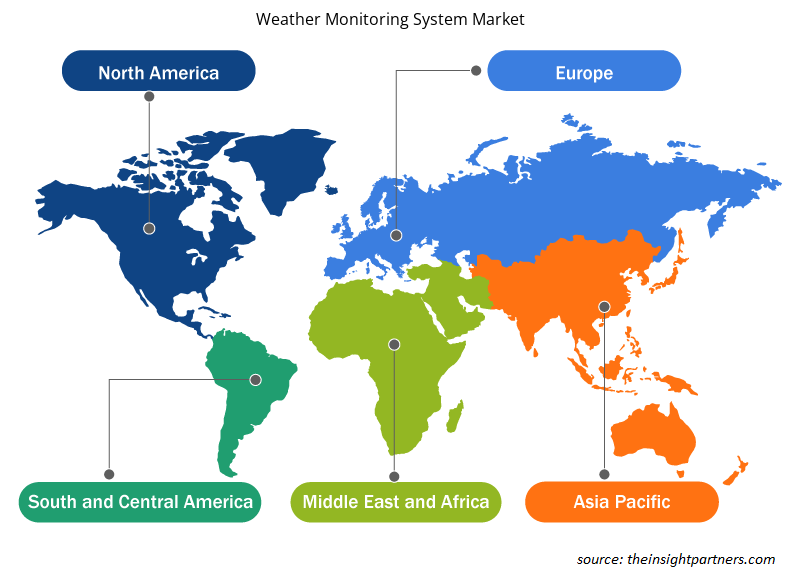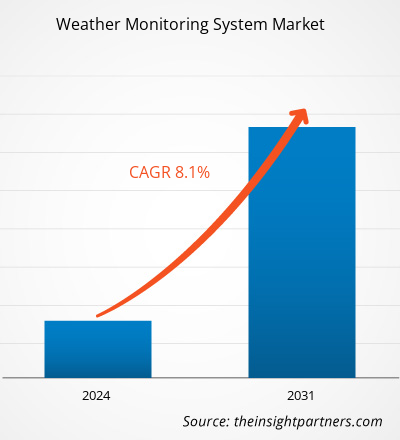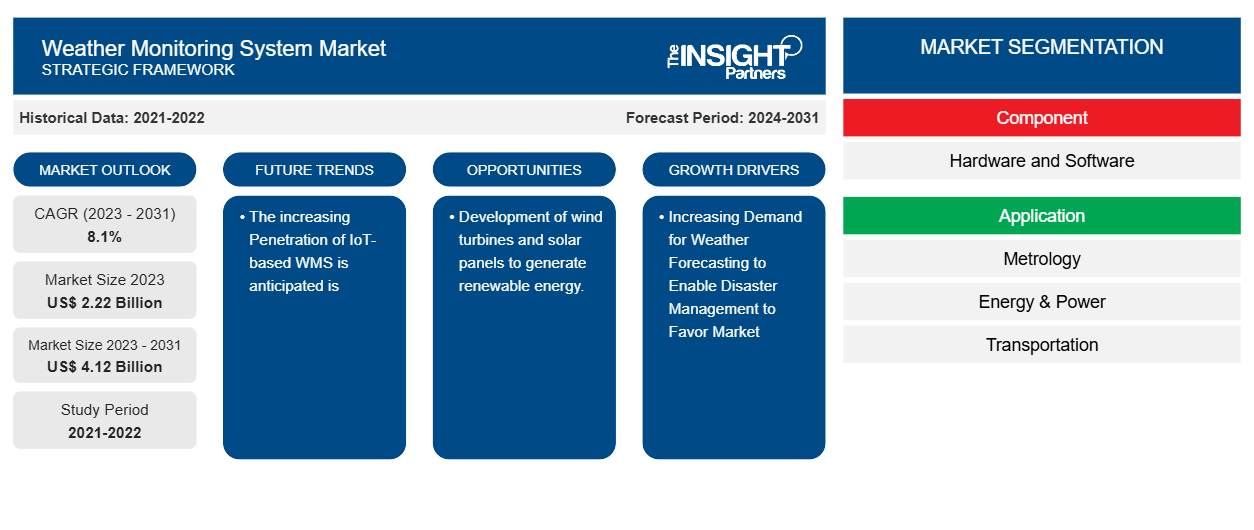Le marché des systèmes de surveillance météorologique (WMS) devrait atteindre 4,12 milliards USD d’ici 2031, contre 2,22 milliards USD en 2023. Le marché devrait enregistrer un TCAC de 8,1 % au cours de la période 2023-2031. L’utilisation croissante des prévisions météorologiques pour permettre la gestion des catastrophes et la demande croissante de prévisions météorologiques dans l’industrie aéronautique sont susceptibles d’être les principales tendances et moteurs du marché des systèmes de surveillance météorologique.
Analyse du marché des systèmes de surveillance météorologique
Le marché des systèmes de surveillance météorologique connaît une croissance substantielle à l'échelle mondiale. Cette croissance est attribuée au changement climatique qui entraîne des incertitudes météorologiques et à l'utilisation croissante des prévisions météorologiques pour permettre la gestion des catastrophes. En outre, l'augmentation de la production d'énergie renouvelable, l'augmentation des capacités de calcul des superordinateurs pour les prévisions météorologiques et la pénétration croissante des WMS basés sur l'IoT.
Aperçu du marché des systèmes de surveillance météorologique
La surveillance ou l'analyse continue ou périodique de l'état du climat et de l'atmosphère, y compris des variables telles que la température, l'humidité, la vitesse du vent et la pression barométrique. De plus, les capteurs de température et d'humidité sont les capteurs météorologiques les plus fréquemment utilisés. Ils peuvent être utilisés pour calculer un indice de chaleur, comprendre si les plantes risquent d'être endommagées par une température trop élevée ou déterminer s'il est sécuritaire de travailler dans une zone donnée.
Personnalisez ce rapport en fonction de vos besoins
Vous bénéficierez d'une personnalisation gratuite de n'importe quel rapport, y compris de certaines parties de ce rapport, d'une analyse au niveau des pays, d'un pack de données Excel, ainsi que d'offres et de remises exceptionnelles pour les start-ups et les universités.
-
Obtenez les principales tendances clés du marché de ce rapport.Cet échantillon GRATUIT comprendra une analyse de données, allant des tendances du marché aux estimations et prévisions.
Moteurs et opportunités du marché des systèmes de surveillance météorologique
La demande croissante de prévisions météorologiques pour permettre la gestion des catastrophes favorise le marché
La demande croissante de prévisions météorologiques pour permettre la gestion des catastrophes est en effet un moteur du marché des systèmes de surveillance météorologique. Les moniteurs/stations météorologiques servent d'outils essentiels pour la préparation et la réponse aux catastrophes. En fournissant des données météorologiques précises et opportunes, ces moniteurs permettent aux individus, aux communautés et aux autorités de planifier, d'atténuer les risques et de réagir efficacement aux catastrophes. Les stations météorologiques servent de pont entre les observations météorologiques et la gestion des catastrophes, favorisant des sociétés plus sûres et plus résilientes. À mesure que la technologie continue de progresser, l'adoption d'approches innovantes et l'intégration de nouvelles capacités renforceront le rôle des stations météorologiques dans l'avenir de la gestion des catastrophes. Ainsi, compte tenu des paramètres ci-dessus, l'utilisation croissante des prévisions météorologiques pour permettre la gestion des catastrophes agit comme l'un des moteurs de la croissance du marché des systèmes de surveillance météorologique.
Développement d'éoliennes et de panneaux solaires pour produire de l'énergie renouvelable.
Un WMS est l'un des composants clés d'une centrale solaire. Sa fonction est de collecter des données sur les paramètres météorologiques tels que la température de surface du module, le rayonnement solaire, la température ambiante, la vitesse du vent, etc., sur n'importe quel site solaire photovoltaïque, ce qui permet de surveiller l'efficacité et les performances de la centrale électrique. L'analyse plus approfondie de ces données par rapport à la production de la centrale permet d'analyser et d'améliorer les performances de la centrale. De plus, pour la mesure des données météorologiques de la centrale éolienne , la station météorologique basée sur l'enregistreur de données SmartSolo est installée sur la tour météorologique permanente pour mesurer la vitesse et la direction du vent à deux hauteurs, ainsi que la température, l'humidité relative et la pression atmosphérique. Ainsi, en raison des paramètres ci-dessus, le développement d'éoliennes et de panneaux solaires pour produire de l'énergie renouvelable devrait offrir plusieurs opportunités pour le marché des systèmes de surveillance météorologique dans les années à venir.
Analyse de segmentation du rapport sur le marché des systèmes de surveillance météorologique
Les segments clés qui ont contribué à l’élaboration de l’analyse du marché du système de surveillance météorologique sont les composants et les applications.
- En fonction des composants, le marché des systèmes de surveillance météorologique est divisé en matériel et en logiciel. Le segment du matériel devrait détenir une part de marché importante au cours de la période de prévision.
- En termes d'application, le marché est segmenté en métrologie, énergie et électricité, transport, aviation et autres. Le segment de la métrologie devrait détenir une part de marché importante au cours de la période de prévision.
Analyse des parts de marché des systèmes de surveillance météorologique par zone géographique
La portée géographique du rapport sur le marché des systèmes de surveillance météorologique est principalement divisée en cinq régions : Amérique du Nord, Asie-Pacifique, Europe, Moyen-Orient et Afrique, et Amérique du Sud et centrale.
L'Amérique du Nord a dominé le marché des systèmes de surveillance météorologique. Le marché nord-américain est segmenté en États-Unis, Canada et Mexique. Les tendances d'adoption de haute technologie dans diverses industries de la région nord-américaine ont alimenté la croissance du marché des systèmes de surveillance météorologique. Des facteurs tels que l'adoption accrue d'outils numériques, les dépenses technologiques élevées des agences gouvernementales et le modèle de changement climatique dans la région conduisent à des incertitudes météorologiques, et l'utilisation croissante des prévisions météorologiques pour permettre la gestion des catastrophes devrait stimuler la croissance du marché des systèmes de surveillance météorologique en Amérique du Nord. De plus, l'accent mis sur la recherche et le développement dans les économies développées des États-Unis et du Canada oblige les acteurs nord-américains à apporter des solutions technologiquement avancées sur le marché. En outre, les États-Unis comptent un grand nombre d'acteurs du marché des systèmes de surveillance météorologique qui se concentrent de plus en plus sur le développement de solutions innovantes. Tous ces facteurs contribuent à la croissance du marché des systèmes de surveillance météorologique de la région.
Aperçu régional du marché des systèmes de surveillance météorologique
Les tendances régionales et les facteurs influençant le marché des systèmes de surveillance météorologique tout au long de la période de prévision ont été expliqués en détail par les analystes d’Insight Partners. Cette section traite également des segments et de la géographie du marché des systèmes de surveillance météorologique en Amérique du Nord, en Europe, en Asie-Pacifique, au Moyen-Orient et en Afrique, ainsi qu’en Amérique du Sud et en Amérique centrale.

- Obtenez les données régionales spécifiques au marché des systèmes de surveillance météorologique
Portée du rapport sur le marché des systèmes de surveillance météorologique
| Attribut de rapport | Détails |
|---|---|
| Taille du marché en 2023 | 2,22 milliards de dollars américains |
| Taille du marché d'ici 2031 | 4,12 milliards de dollars américains |
| Taux de croissance annuel composé mondial (2023-2031) | 8,1% |
| Données historiques | 2021-2022 |
| Période de prévision | 2024-2031 |
| Segments couverts |
Par composant
|
| Régions et pays couverts |
Amérique du Nord
|
| Leaders du marché et profils d'entreprises clés |
|
Densité des acteurs du marché des systèmes de surveillance météorologique : comprendre son impact sur la dynamique des entreprises
Le marché des systèmes de surveillance météorologique connaît une croissance rapide, tirée par la demande croissante des utilisateurs finaux en raison de facteurs tels que l'évolution des préférences des consommateurs, les avancées technologiques et une plus grande sensibilisation aux avantages du produit. À mesure que la demande augmente, les entreprises élargissent leurs offres, innovent pour répondre aux besoins des consommateurs et capitalisent sur les tendances émergentes, ce qui alimente davantage la croissance du marché.
La densité des acteurs du marché fait référence à la répartition des entreprises ou des sociétés opérant sur un marché ou un secteur particulier. Elle indique le nombre de concurrents (acteurs du marché) présents sur un marché donné par rapport à sa taille ou à sa valeur marchande totale.
Les principales entreprises opérant sur le marché des systèmes de surveillance météorologique sont :
- Vaisala
- Toucher la Trinité
- Trafitek Solutions Private Ltd.
- Télégraphie comme
- Systèmes de détection de foudre Boltek
- Esprits libres Green Labs Pvt Ltd
Avis de non-responsabilité : les sociétés répertoriées ci-dessus ne sont pas classées dans un ordre particulier.

- Obtenez un aperçu des principaux acteurs du marché des systèmes de surveillance météorologique
Actualités et développements récents du marché des systèmes de surveillance météorologique
Le marché des systèmes de surveillance météorologique est évalué en collectant des données qualitatives et quantitatives après des recherches primaires et secondaires, qui comprennent d'importantes publications d'entreprise, des données d'association et des bases de données. Quelques-uns des développements sur le marché des systèmes de surveillance météorologique sont énumérés ci-dessous :
- Une fusée Falcon 9 de SpaceX a lancé le 11 avril un satellite de surveillance météorologique de la Force spatiale américaine. (Source : site Web de la société SpaceX, avril 2024)
- L'Organisation indienne de recherche spatiale (Isro) a lancé avec succès INSAT-3DS, un satellite de surveillance météorologique et d'alerte aux catastrophes. Le satellite a été lancé au sommet de la fusée GSLV-F14 depuis Sriharikota. (Source : ISRO, communiqué de presse, février 2024)
Rapport sur le marché des systèmes de surveillance météorologique : couverture et livrables
Le rapport « Taille et prévisions du marché des systèmes de surveillance météorologique (2021-2031) » fournit une analyse détaillée du marché couvrant les domaines ci-dessous :
- Taille et prévisions du marché des systèmes de surveillance météorologique aux niveaux mondial, régional et national pour tous les segments de marché clés couverts par le champ d’application.
- Tendances du marché des systèmes de surveillance météorologique ainsi que dynamique du marché telles que les moteurs, les contraintes et les opportunités clés.
- Analyse détaillée des cinq forces de PEST/Porter et SWOT.
- Analyse du marché des systèmes de surveillance météorologique couvrant les principales tendances du marché, le cadre mondial et régional, les principaux acteurs, les réglementations et les développements récents du marché.
- Analyse du paysage industriel et de la concurrence couvrant la concentration du marché, l'analyse de la carte thermique, les principaux acteurs et les développements récents pour le marché des systèmes de surveillance météorologique.
- Profils d'entreprise détaillés.
- Analyse historique (2 ans), année de base, prévision (7 ans) avec TCAC
- Analyse PEST et SWOT
- Taille du marché Valeur / Volume - Mondial, Régional, Pays
- Industrie et paysage concurrentiel
- Ensemble de données Excel
Rapports récents
Témoignages
Raison d'acheter
- Prise de décision éclairée
- Compréhension de la dynamique du marché
- Analyse concurrentielle
- Connaissances clients
- Prévisions de marché
- Atténuation des risques
- Planification stratégique
- Justification des investissements
- Identification des marchés émergents
- Amélioration des stratégies marketing
- Amélioration de l'efficacité opérationnelle
- Alignement sur les tendances réglementaires























 Obtenez un échantillon gratuit pour - Marché des systèmes de surveillance météorologique
Obtenez un échantillon gratuit pour - Marché des systèmes de surveillance météorologique